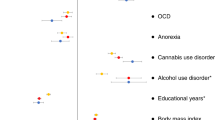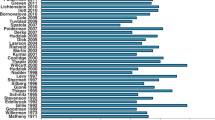Abstract
We address the use of two informants in genetic studies and whether familial aggregation is similar for the three phenotypic subtypes of ADHD. Lifetime ADHD was diagnosed in a Dutch isolated population using parents and teachers as informants, creating two subgroups (one or two informants), then further divided into three phenotypic categories (inattentive, hyperactive/impulsive, combined). Genealogy was collected for all patients. Mean kinship coefficients for the subgroups were calculated. Fifteen of 26 children were linked to a common ancestor within 10 generations. The mean kinship coefficient of patients confirmed by two informants was significantly higher than in patients only scored positive by one informant (p = 0.03). All patients of the inattentive subtype were connected to a common ancestor, which was significantly higher (p = 0.03) than expected. Eighty-one percent of these patients derive of consanguineous marriages, also higher than expected. This means that recessive mutations may be involved in the inattentive subtype. These patients were more closely related than those with the other phenotypes (p<0.01). Our data suggests that using two informants in diagnosing ADHD helps identify a phenotype with a strong genetic component. The inattentive phenotype showed strong familial clustering and evidence of a recessive origin.
Similar content being viewed by others
References
FC Verhulst J Ende Particlevan der RF Ferdinand MC Kasius (1997) ArticleTitleThe prevalence of DSM-III-R diagnoses in a national sample of Dutch adolescents Arch Gen Psychiatry 54 IssueID4 329–336 Occurrence Handle9107149
RA Barkley (2003) ArticleTitleIssues in the diagnosis of attention-deficit/hyperactivity disorder in children Brain Dev 25 IssueID2 77–83 Occurrence Handle10.1016/S0387-7604(02)00152-3 Occurrence Handle12581803
M Gaub CL Carlson (1997) ArticleTitleGender differences in ADHD: A meta-analysis and critical review J Am Acad Child Adolesc Psychiatry 36 IssueID8 1036–1045 Occurrence Handle10.1097/00004583-199708000-00011 Occurrence Handle9256583
JC Hill EP Schoener (1996) ArticleTitleAge-dependent decline of attention deficit hyperactivity disorder Am J Psychiatry 153 IssueID9 1143–1146 Occurrence Handle8780416
DP Cantwell (1996) ArticleTitleAttention deficit disorder: A review of the past 10 years J Am Acad Child Adolesc Psychiatry 35 IssueID8 978–987 Occurrence Handle10.1097/00004583-199608000-00008 Occurrence Handle8755794
RA Barkley (1996) Attention deficit/hyperactivity disorder RA Barkley (Eds) Child Psychopathology Guildford Press New York 63–112
SV Faraone J Biederman E Mick et al. (2001) ArticleTitleA family study of psychiatric comorbidity in girls and boys with attention-deficit/hyperactivity disorder Biol Psychiatry 50 IssueID8 586–592 Occurrence Handle10.1016/S0006-3223(01)01146-5 Occurrence Handle11690593
SV Faraone J Biederman MC Monuteaux (2000) ArticleTitleToward guidelines for pedigree selection in genetic studies of attention deficit hyperactivity disorder Genet Epidemiol 18 IssueID1 1–16 Occurrence Handle10.1002/(SICI)1098-2272(200001)18:1<1::AID-GEPI1>3.0.CO;2-X Occurrence Handle10603455
F Levy DA Hay M McStephen C Wood I Waldman (1997) ArticleTitleAttention-deficit hyperactivity disorder: A category or a continuum? Genetic analysis of a large-scale twin study J Am Acad Child Adolesc Psychiatry 36 IssueID6 737–744 Occurrence Handle10.1097/00004583-199706000-00009 Occurrence Handle9183127
A Thapar A Hervas P McGuffin (1995) ArticleTitleChildhood hyperactivity scores are highly heritable and show sibling competition effects: Twin study evidence Behav Genet 25 IssueID6 537–544 Occurrence Handle8540892
F Lopera LG Palacio I Jimenez et al. (1999) ArticleTitle[Discrimination between genetic factors in attention deficit] Discriminacion de factores geneticos en el deficit de atencion Rev Neurol 28 IssueID7 660–664 Occurrence Handle10363289
A Thapar J Holmes K Poulton R Harrington (1999) ArticleTitleGenetic basis of attention deficit and hyperactivity Br J Psychiatry 174 105–111 Occurrence Handle10211163
D Shaffer P Fisher CP Lucas MK Dulcan ME. Schwab-Stone (2000) ArticleTitleNIMH Diagnostic Interview Schedule for Children Version IV (NIMH DISC-IV): description, differences from previous versions, and reliability of some common diagnoses J Am Acad Child Adolesc Psychiatry 39 IssueID1 28–38 Occurrence Handle10.1097/00004583-200001000-00014 Occurrence Handle10638065
TM Achenbach SH McConaughy CT Howell (1987) ArticleTitleChild/adolescent behavioral and emotional problems: Implications of cross-informant correlations for situational specificity Psychol Bull 101 IssueID2 213–232 Occurrence Handle10.1037//0033-2909.101.2.213 Occurrence Handle3562706
RF Ferdinand KN Hoogerheide J Ende Particlevan der et al. (2003) ArticleTitleThe role of the clinician: three-year predictive value of parents: Teachers’ and clinicians’ judgment of childhood psychopathology J Child Psychol Psychiatry 44 IssueID6 867–876 Occurrence Handle10.1111/1469-7610.00171 Occurrence Handle12959495
JVd Ende (1999) Multiple informants: Multiple views HMCA Koot RF Ferdinand (Eds) Child Psychiatric Epidemiology. Accomplishments and Future Directions Van Gorcum & Company Assen (The Netherlands) 39–52
EM Mitsis KE McKay KP Schulz JH Newcorn JM Halperin (2000) ArticleTitleParent-teacher concordance for DSM-IV attention-deficit/hyperactivity disorder in a clinic-referred sample J Am Acad Child Adolesc Psychiatry 39 IssueID3 308–313 Occurrence Handle10.1097/00004583-200003000-00012 Occurrence Handle10714050
FC Verhulst HM Koot J Ende ParticleVan der (1994) ArticleTitleDifferential predictive value of parents’ and teachers’ reports of children’s problem behaviors: A longitudinal study J Abnorm Child Psychol 22 IssueID5 531–546 Occurrence Handle7822627
Nijs PdF RF, de Bruin EI, Dekker MCJ, van Duijn CM, Verhulst FC. Attention-deficit/hyperactivity disorder (ADHD): parents’ judgment about school, teachers’ judgment about home. Eur Child Adolesc Psychiatry 2004; 13(5): 315–320.
YS Aulchenko N Vaessen P Heutink et al. (2003) ArticleTitleA genome-wide search for genes involved in type 2 diabetes in a recently genetically isolated population from the Netherlands Diabetes 52 IssueID12 3001–3004 Occurrence Handle14633863
N Vaessen P Heutink JJ Houwing-Duistermaat et al. (2002) ArticleTitleA genome-wide search for linkage-disequilibrium with type 1 diabetes in a recent genetically isolated population from the Netherlands Diabetes 51 IssueID3 856–859 Occurrence Handle11872691
Ferdinand RF, van der Ende J. NIMH DISC-IV: Diagnostic Interview Schedule for Children. Authorized Dutch translation. In: Erasmus MC Sophia: Rotterdam, The Netherlands; 2000.
Zwetselaar M. PEDKIN, software to calculate kinship and inbreeding coefficients. In: http://www.zwets.com/pedkin; 2003.
V Bonifati P Rizzu F Squitieri et al. (2003) ArticleTitleDJ-1( PARK7), a novel gene for autosomal recessive, early onset parkinsonism Neurol Sci 24 IssueID3 159–160 Occurrence Handle10.1007/s10072-003-0108-0 Occurrence Handle14598065
Roks GPH, van Swieten J, Cruts M, et al. Alzheimer’s disease in a Dutch recent genetically isolated population. The GRIP Study, in Alzheimer’s disease. A genetic epidemiologic approach. Erasmus MC: Rotterdam. 2001, p. 83–90.
DS Crystal R Ostrander RS Chen GJ August (2001) ArticleTitleMultimethod assessment of psychopathology among DSM-IV subtypes of children with attention-deficit/hyperactivity disorder: Self-, parent, and teacher reports J Abnorm Child Psychol 29 IssueID3 189–205 Occurrence Handle10.1023/A:1010325513911 Occurrence Handle11411782
N Martin J Scourfield P McGuffin (2002) ArticleTitleObserver effects and heritability of childhood attention-deficit hyperactivity disorder symptoms Br J Psychiatry 180 260–265 Occurrence Handle10.1192/bjp.180.3.260 Occurrence Handle11872519
A Thapar R Harrington K Ross P McGuffin (2000) ArticleTitleDoes the definition of ADHD affect heritability? J Am Acad Child Adolesc Psychiatry 39 IssueID12 1528–1536 Occurrence Handle10.1097/00004583-200012000-00015 Occurrence Handle11128330
RD. Todd ER Rasmussen RJ Neuman et al. (2001) ArticleTitleFamiliality and heritability of subtypes of attention deficit hyperactivity disorder in a population sample of adolescent female twins Am J Psychiatry 158 IssueID11 1891–1898 Occurrence Handle10.1176/appi.ajp.158.11.1891 Occurrence Handle11691697
RJ Neuman A Heath W Reich et al. (2001) ArticleTitleLatent class analysis of ADHD and comorbid symptoms in a population sample of adolescent female twins J Child Psychol Psychiatry 42 IssueID7 933–942 Occurrence Handle10.1111/1469-7610.00789 Occurrence Handle11693588
Author information
Authors and Affiliations
Corresponding author
Rights and permissions
About this article
Cite this article
Croes, E., El Galta, R., Houwing-Duistermaat, J. et al. Phenotypic Subtypes in Attention Deficit Hyperactivity Disorder in an Isolated Population. Eur J Epidemiol 20, 789–794 (2005). https://doi.org/10.1007/s10654-005-0366-7
Accepted:
Issue Date:
DOI: https://doi.org/10.1007/s10654-005-0366-7




